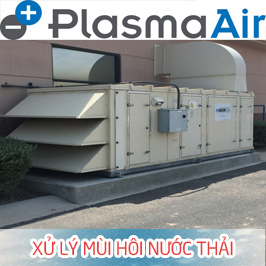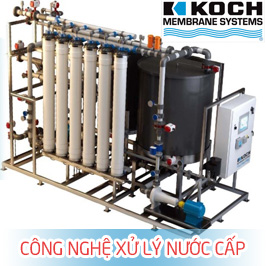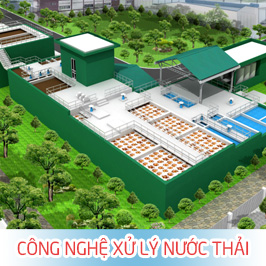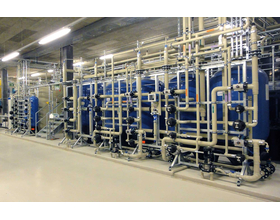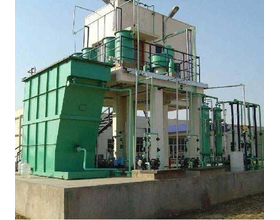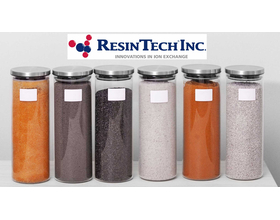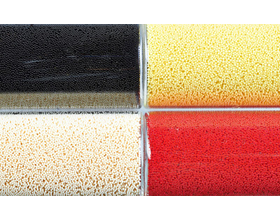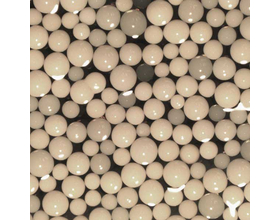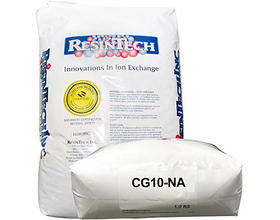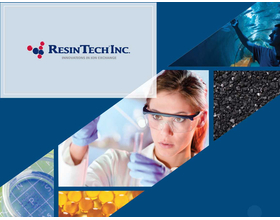Description
CÔNG NGHỆ XỬ LÝ NƯỚC THẢI BẰNG TRAO ĐỔI ION
WASTEWATER TREATMENT TECHNOLOGY BY ION EXCHANGE RESINS

Manufacturers: RESINTECH - USA
Tài liệu download brochue (vui lòng click link google drive dưới đây)
- Download links: Brochure tổng quan các sản phẩm RESINTECH (product summary)
- Download links: Catalogue hạt nhựa trao đổi ion RESINTECH
Công ty Môi Trường Hành Trình Xanh hân hạnh là nhà nhập khẩu và phân phối chính thức Công nghệ xử lý nước thải bằng trao đổi ion Resintech - USA. tại Việt Nam. Chúng tôi cam kết cung cấp sản phẩm và dịch vụ tốt nhất tới Quý Khách hàng.
ResinTech has been manufacturing a broad range of ion exchange resins for water and wastewater treatment since 1986, including cation resin, anion resin, mixed bed resin, macroporous resin, potable water grade resin, semiconductor grade resin etc. In the past four decades, we've been working with customers all over the world and have developed hundreds of resin models as per different customers and applications required, including deionization, softening, metals removal, product purification, resource recovery, pollution control, hydrometallurgy, as well as Municipal Water Treatment. Every batch of resin sold by ResinTech is fully tested and must pass a full battery of QC testing before being placed in active inventory. All ResinTech resins are manufactured to specifications that meet or exceed all published specifications for other manufacturers' equivalent products. / ResinTech đã sản xuất nhiều loại nhựa trao đổi ion để xử lý nước và nước thải kể từ năm 1986, bao gồm nhựa cation, nhựa anion, nhựa hỗn hợp, nhựa macroporous, nhựa cấp nước uống được, nhựa bán dẫn, v.v. Trong bốn thập kỷ qua, chúng tôi 'đã làm việc với các khách hàng trên toàn thế giới và đã phát triển hàng trăm mẫu nhựa theo yêu cầu của các khách hàng và ứng dụng khác nhau, bao gồm khử ion, làm mềm, loại bỏ kim loại, làm sạch sản phẩm, phục hồi tài nguyên, kiểm soát ô nhiễm, luyện kim thủy lực, cũng như Xử lý nước đô thị . Mỗi lô nhựa do ResinTech bán ra đều được kiểm tra đầy đủ và phải vượt qua kiểm tra QC đầy đủ trước khi được đưa vào kho hoạt động. Tất cả các loại nhựa ResinTech đều được sản xuất theo các thông số kỹ thuật đáp ứng hoặc vượt quá tất cả các thông số kỹ thuật đã công bố cho các sản phẩm tương đương của các nhà sản xuất khác.
1. WASTEWATER TREATMENT BY ION EXCHANGE RESINS / CÔNG NGHỆ XỬ LÝ NƯỚC THẢI BẰNG TRAO ĐỔI ION
Wastewater treatment systems face increasingly stringent discharge limitations, in many cases lower than the limits for the supplies used as feedwater. Ion exchange resins and adsorbent medias are often ideally suited for removal of specific contaminants and/or for polishing the effluent from other wastewater treatment processes. / Các hệ thống xử lý nước thải phải đối mặt với những giới hạn xả thải ngày càng nghiêm ngặt, trong nhiều trường hợp thấp hơn giới hạn đối với nguồn cung cấp được sử dụng làm nước cấp. Nhựa trao đổi ion và chất trung gian hấp phụ thường thích hợp lý tưởng để loại bỏ các chất gây ô nhiễm cụ thể và / hoặc để đánh bóng nước thải từ các quy trình xử lý nước thải khác.
ResinTech provides a large number of products for wastewater treatment including chelating resins, resins suitable for organic scavenging and resins for selected removal of specific contaminants, such as boron, Nickel, Chromium, Ammonium, phosphate, heavy metals, arsenic etc. / ResinTech cung cấp một số lượng lớn các sản phẩm để xử lý nước thải bao gồm nhựa chelating, nhựa thích hợp để xử lý hữu cơ và nhựa để loại bỏ được chọn lọc các chất gây ô nhiễm cụ thể, chẳng hạn như boron, Niken, Crom, Amoni, phốt phát, kim loại nặng, asen, v.v.
Although the possibilities are almost endless, ResinTech’s expert technical staff is familiar with most commercially viable processes and can provide guidance and basic capacity/leakage data for all of our full line of ion exchange and adsorbent products. / Mặc dù kiến thức gần như vô tận, đội ngũ kỹ thuật chuyên gia của ResinTech đã quen thuộc với hầu hết các quy trình khả thi về mặt thương mại và có thể cung cấp hướng dẫn và dữ liệu công suất / dung lượng cơ bản cho tất cả các dòng sản phẩm chất hấp phụ và trao đổi ion đầy đủ của chúng tôi.
ResinTech ion exchange products are available in many container sizes, mesh sizes, and can be specially prepared to be pH buffered or in a specific ionic form, ready to use. Many of these products are also available with the WQA Gold Seal certification to the ANSI/NSF 61 standard for potable water. / Sản phẩm trao đổi ion ResinTech có nhiều kích thước thùng chứa, kích thước mắt lưới, và có thể được điều chế đặc biệt để được đệm pH hoặc ở dạng ion cụ thể, sẵn sàng sử dụng. Nhiều sản phẩm trong số này cũng có chứng nhận WQA Gold Seal theo tiêu chuẩn ANSI / NSF 61 cho nước uống được.

| SIR-100-HP | Nitrate selective strong base anion resin. / Nhựa anion gốc mạnh chọn lọc nitrat. |
| SIR-110-HP | Perchlorate selective strong base anion resin. / nhựa anion gốc mạnh chọn lọc muối Perchlorate |
| SIR-150 | Boron selective weak base anion resin with N-Methyl glucamine functional groups. (Call For Specifications) / Nhựa anion bazơ yếu chọn lọc boron với các nhóm chức N-Methyl glucamine. |
| SIR-200 | Mercury and heavy metal selective very weakly acidic cation resin with thiol functional groups. / Nhựa cation chọn lọc thủy ngân và kim loại nặng có tính axit rất yếu với các nhóm chức thiol. |
| SIR-300 | Iminodiacetic weakly acidic chelating resin selective for divalent transition metals such as Cu, Ni, Zn, Cd etc. / Nhựa chelat có tính axit yếu Iminodiacetic chọn lọc cho các kim loại chuyển tiếp hóa trị hai như Cu, Ni, Zn, Cd, v.v. |
| SIR-400 | Mercury and precious metal selective weakly basic anion resin with thiouronium functional groups. / Thủy ngân và kim loại quý nhựa anion có tính bazơ yếu chọn lọc với các nhóm chức thiouronium. |
| SIR-500 | Aminophosphonic weakly acidic chelating resin selective for hardness ions as well as divalent transition metals such as Cu, Ni, Zn, Cd etc. / Nhựa chelating aminophosphonic có tính axit yếu chọn lọc cho các ion độ cứng cũng như các kim loại chuyển tiếp hóa trị hai như Cu, Ni, Zn, Cd, v.v. |
| SIR-600 | Specially prepared natural zeolite selective for potassium, ammonia and cesium. / Zeolit tự nhiên được điều chế đặc biệt chọn lọc cho kali, amoniac và xêzi. |
| SIR-700 | Acid sulfate form granular weak base resin with exceptionally high capacity for hexavalent chrome. / Axit sunfat tạo thành nhựa gốc yếu dạng hạt với khả năng đặc biệt cao đối với crom hóa trị sáu. |
| SIR-800 | Sulfite form strong base anion resin for oxygen removal in polishing applications. / Sulfite tạo thành nhựa anion gốc mạnh để loại bỏ oxy trong các ứng dụng khử khoáng. |
| SIR-900 | Aluminum oxide adsorbent, selective for fluoride, arsenic, lead etc. / Chất hấp phụ oxit nhôm, chọn lọc cho florua, asen, chì, v.v. |
| SIR-1000 | Picolylamine weak base chelating resin selective for copper and other divalent transition metals even in highly acidic solutions. / Nhựa chelat hóa bazơ yếu Picolylamine chọn lọc cho đồng và các kim loại chuyển tiếp hóa trị hai khác ngay cả trong các dung dịch có tính axit cao. |
| SIR-1200 | Specially prepared strong base anion resin used for removal of natural uranium. / Nhựa anion gốc mạnh được điều chế đặc biệt dùng để loại bỏ uranium tự nhiên. |

Our MIST-X® design software can model various combinations on a made-to-measure basis and thus provides users with maximum confidence that they will find the optimum treatment solution. / Phần mềm thiết kế MIST-X® của chúng tôi có thể lập mô hình các kết hợp khác nhau trên cơ sở đo lường thực tế và do đó cung cấp cho người dùng sự tin tưởng tối đa rằng họ sẽ tìm ra giải pháp xử lý tối ưu.

In addition to providing unique resin solutions for a wide range of challenging applications, ResinTech is recognized globally for outstanding technical sales and support, a customer-centered approach, and top-tier research and development resources and laboratories. / Ngoài việc cung cấp các giải pháp nhựa độc đáo cho một loạt các ứng dụng đầy thách thức, ResinTech được công nhận trên toàn cầu về doanh số và hỗ trợ kỹ thuật xuất sắc, phương pháp tiếp cận lấy khách hàng làm trung tâm cũng như các phòng thí nghiệm và tài nguyên nghiên cứu và phát triển hàng đầu.
We are working continuously with customers to identify new, innovative applications for such polymer catalysts and to develop new, customized product types. / Chúng tôi đang làm việc liên tục với khách hàng để xác định các ứng dụng mới, sáng tạo cho các chất xúc tác polyme như vậy và phát triển các loại sản phẩm mới, tùy chỉnh.

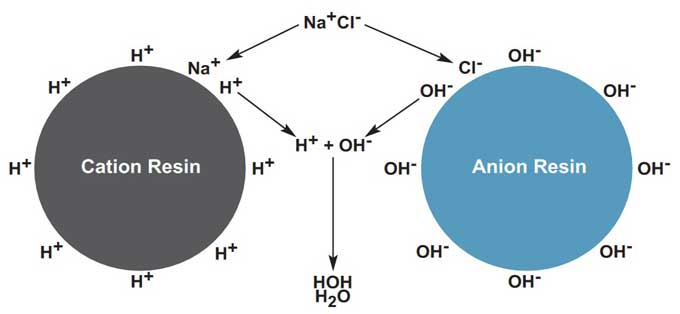
2. Tổng quan các chất ô nhiễm xử lý bằng nhựa trao đổi ion RESINTECH

3. Cation Resin / Hạt nhựa Cation
Cation ion exchange resins may be light or dark in color. Color variation in new cation has no impact on its performance. For drinking water applications look for WQA Gold Seal or NSF certified products. / Nhựa trao đổi ion cation có thể có màu sáng hoặc tối. Sự thay đổi màu sắc trong cation không ảnh hưởng đến hiệu suất của nó. Đối với các ứng dụng nước uống, hãy tìm kiếm các sản phẩm được chứng nhận bởi WQA Gold Seal hoặc NSF.

Cation resins by type are: / Phân loại Nhựa cation là:
- Strong Acid Cation (SAC) resin are sulfonated copolymers of styrene and DVB. / Nhựa Cation axit mạnh (SAC) là chất đồng trùng hợp sulfo hóa của styren và DVB.
- Weak Acid Cations (WAC) have a polyacrylic backbone. / Nhựa Cation axit yếu (WAC) có cấu trúc bằng polyacrylic.
- SAC and WAC resins are manufactured in different forms – macroporous and porous (gel). / Nhựa SAC và WAC được sản xuất ở các dạng khác nhau - dạng xốp (macroporous) và dạng xốp (gel).
Cation resins in the Na+ form will exchange sodium for the following ions: / Nhựa cation ở dạng Na + sẽ trao đổi natri cho các ion sau:
- Calcium (Ca++)
- Magnesium (Mg++)
- Iron (Fe++)
- Manganese (Mn++)
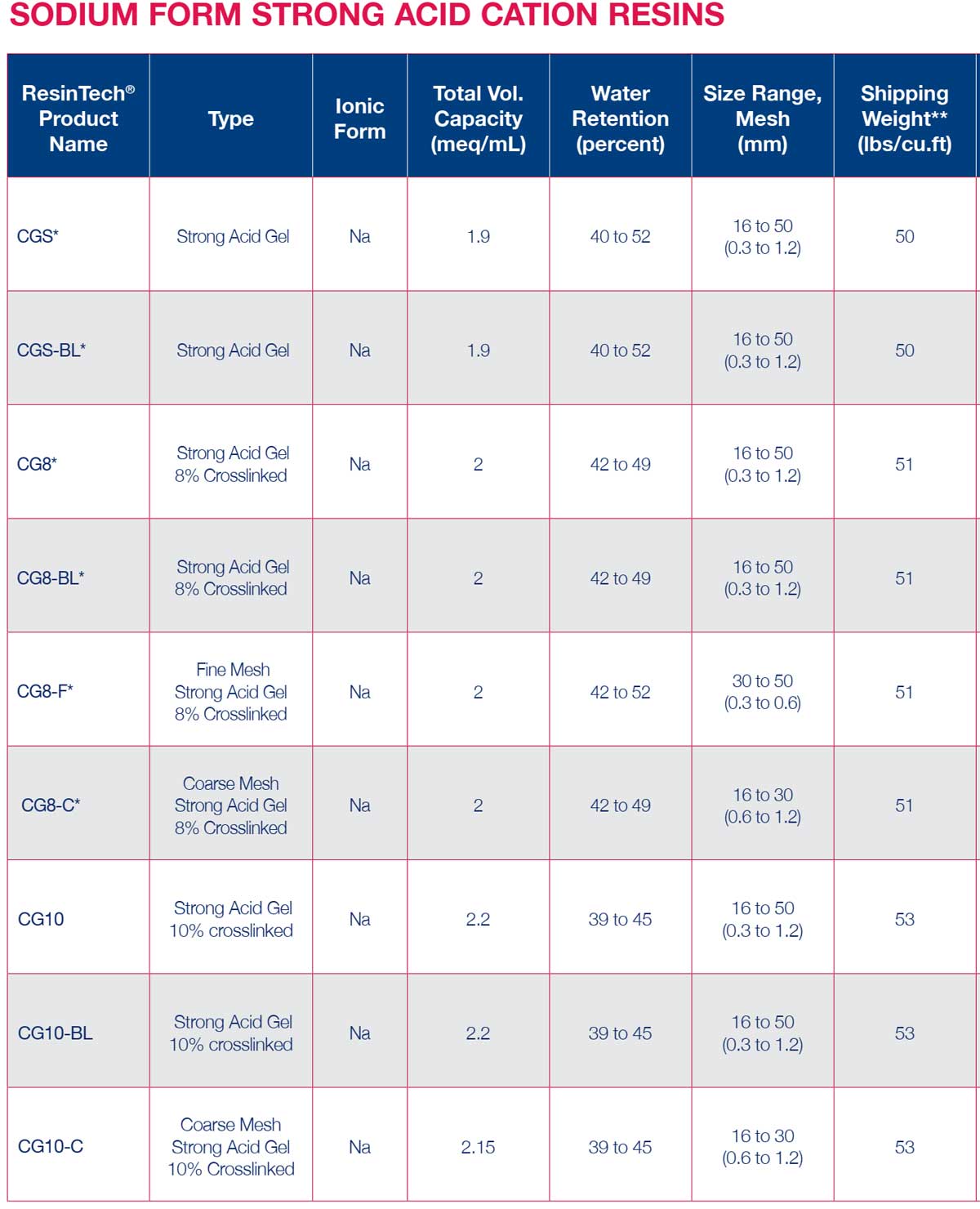
In the H+ cation resin will exchange hydrogen for the following ions: / Trong nhựa cation H + sẽ trao đổi hydro cho các ion sau:
- Calcium (Ca++)
- Magnesium (Mg++)
- Manganese (Mn++)
- Iron (Fe++)
- Sodium (Na+)

3.1. Strong Acid Cation Resins / Nhựa Cation gốc axit mạnh
Strongly acidic cation resins derive their functionality from the sulfonic acid groups. These strong acid exchangers operate at any pH, split all salts, and require substantial amounts of regenerant. This is the resin of choice for almost all softening applications and as the first unit in a two bed demineralizer or as the cation component of a mixed bed. / Nhựa cation có tính axit mạnh tạo ra chức năng của chúng từ các nhóm axit sulfonic. Các chất trao đổi axit mạnh này hoạt động ở bất kỳ độ pH nào, tách tất cả các muối và yêu cầu một lượng đáng kể chất tái sinh. Đây là loại nhựa được lựa chọn cho hầu hết các ứng dụng làm mềm và là đơn vị đầu tiên trong thiết bị khử khoáng hai lớp hoặc như thành phần cation của lớp hỗn hợp.
Gel type cation resin consists of clear or translucent beads, and is commonly used in standard applications such as softening. It has greater capacity and regeneration efficiency than macroporous cation. Gel type cation resin is often referred to by its cross-linkage percentage. / Nhựa cation loại gel bao gồm các hạt trong hoặc mờ, và thường được sử dụng trong các ứng dụng tiêu chuẩn như làm mềm. Nó có công suất và hiệu suất tái sinh lớn hơn cation macroporous. Nhựa cation loại gel thường được gọi bằng tỷ lệ phần trăm liên kết chéo (cross-linked) của nó.
- Higher cross-linked cation exchange resins can withstand more aggressive circumstances – e.g. higher chlorine levels. / Các loại nhựa trao đổi cation liên kết chéo cao hơn có thể chịu được các trường hợp khắc nghiệt hơn - ví dụ: mức clo cao hơn.
- Resins with cross linkage of 6% are commonly used for well water applications. / Nhựa có liên kết ngang 6% thường được sử dụng cho các ứng dụng nước giếng.
- Municipal water has a chlorine residual so 8% cross-linked resins, such as ResinTech CG8, are recommended. / Nước thành phố có dư lượng clo nên các loại nhựa liên kết chéo (cross-linked) 8%, chẳng hạn như ResinTech CG8, được khuyến khích sử dụng.
- 10% cross-linked resins ResinTech CG10 are often installed in commercial industrial applications or where the chlorine or chloramine content is higher than what is recommended by resin manufacturers. / Hạt nhựa liên kết chéo (cross-linked) 10% ResinTech CG10 thường được lắp đặt trong các ứng dụng công nghiệp thương mại hoặc nơi có hàm lượng clo hoặc cloramin cao hơn mức khuyến nghị của các nhà sản xuất nhựa.

Tham khảo: Mức giới hạn Chlorine khuyến nghị sử dụng trong lọc trao đổi ion
When strong acid cation resins are operated in higher chlorine environments, shorter resin life will be expected. The effect of free chlorine is additive, so the reduction in resin lifetime should be proportional to the increase in the level of chlorine in the feed. / Khi nhựa cation axit mạnh được vận hành trong môi trường clo cao hơn, tuổi thọ của nhựa sẽ ngắn hơn. Tác dụng của clo tự do là chất phụ gia, do đó, sự giảm tuổi thọ của nhựa phải tỷ lệ thuận với sự gia tăng mức độ clo trong nước cấp đầu vào.
Macroporous cation beads are opaque. It’s commonly used in aggressive softening applications. / Hạt cation dạng Macroporous có màu trắng đục. Nó thường được sử dụng trong các ứng dụng làm mềm yêu cầu cao.
- High temperatures where oxidants such as chlorine are also present. / Nhiệt độ cao cũng có mặt các chất oxy hóa như clo.
- Although the capacity is lower than gel, macroporous will last longer. / Mặc dù công suất thấp hơn gel nhưng macroporous sẽ có tuổi thọ lâu hơn.
- Macroporous resin has larger pore sizes than gel resin and can be cross-linked by as much as 20% / Nhựa Macroporous có kích thước lỗ lớn hơn so với nhựa gel và có thể được liên kết chéo tới 20%
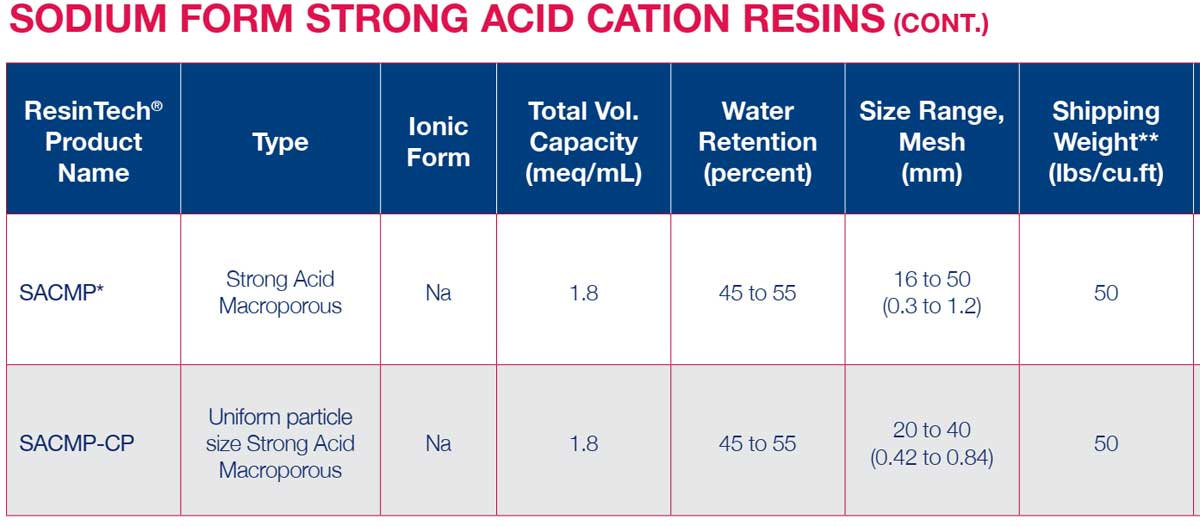
3.2. Weak Acid Cation Resins / Nhựa Cation gốc axit yếu
The weakly acidic cation resins have carboxylic groups as the exchange site. The resin is highly efficient, for it is regenerated with nearly 100% stoichiometric amount of acid, as compared to the 200-300% required for strong acid cations. The weak acid resins are subject to reduced capacity from increasing flow rate, low temperatures, and a hardness-to-alkalinity ratio below 1.0. They are used very effectively in conjunction with a strong acid cation resin operating in the hydrogen form, in either a separate bed or stratified bed configuration. / Các loại nhựa cation có tính axit yếu có các nhóm cacboxylic là vị trí trao đổi. Nhựa có hiệu quả cao, vì nó được tái sinh với lượng axit gần 100% so với 200-300% cần thiết cho các cation axit mạnh. Các loại nhựa axit yếu có thể bị giảm khả năng do tốc độ dòng chảy tăng, nhiệt độ thấp và tỷ lệ độ cứng trên độ kiềm dưới 1,0. Chúng được sử dụng rất hiệu quả cùng với nhựa cation axit mạnh hoạt động ở dạng hydro, trong cấu hình lớp riêng biệt hoặc phân tầng.

Although weak acid cation resin softens water it is never used in residential applications. / Mặc dù nhựa cation axit yếu làm mềm nước nhưng nó không bao giờ được sử dụng trong các ứng dụng dân dụng.
- WAC resin is in the hydrogen form (H+). / Nhựa WAC ở dạng hydro (H +).
- If used in a household setting the pH of the water passing through the system is greatly reduced. / Nếu được sử dụng trong gia đình, độ pH của nước đi qua hệ thống sẽ giảm đáng kể.
- WAC is commonly used to remove alkalinity, to soften water containing high salinity and for removal of heavy metals. / WAC thường được sử dụng để loại bỏ độ kiềm, làm mềm nước có độ mặn cao và loại bỏ các kim loại nặng.


3.3. Cation Exchange Process / Quy trình trao đổi cation
Softening with cation resin is a simple exchange function. / Làm mềm bằng nhựa cation là một chức năng trao đổi đơn giản.
3.3.1. Softening / Làm mềm
- The resin bead is negatively charged and attracts positive ions. / Hạt nhựa mang điện tích âm và thu hút các ion dương.
- When supplied in the sodium form (Na+) the resin will exchange sodium ions for hardness ions – calcium and magnesium. / Khi được cung cấp ở dạng natri (Na +), nhựa sẽ trao đổi các ion natri để lấy các ion độ cứng - canxi và magiê.
- The bead is more strongly attracted to these ions and readily exchanges with the sodium. / Hạt bị thu hút mạnh hơn bởi các ion này và dễ dàng trao đổi với natri.
- Once the resin is exhausted it is regenerated with a brine solution (NaCl). / Khi nhựa cạn kiệt, nó được tái sinh bằng dung dịch nước muối (NaCl).
- The brine overwhelms and releases the calcium and magnesium from the bead. / Nước muối lấn át và giải phóng canxi và magiê từ hạt.
- The resin is “converted” back to the sodium form and ready for re-use. / Nhựa được “chuyển đổi” trở lại dạng natri và sẵn sàng để sử dụng lại.
3.3.2. Iron Reduction / Khử sắt
Other positively charged metals such as ferrous iron and lead are also attracted to the cation resin and will be removed. These metals are not easily regenerated off and will reduce the softening capacity and life of the resin. / Các kim loại tích điện dương khác như sắt và chì cũng bị hút vào nhựa cation và sẽ bị loại bỏ. Những kim loại này không dễ dàng tái sinh và sẽ làm giảm khả năng làm mềm và tuổi thọ của nhựa.
3.3.3. Demineralization / Khử khoáng
SAC in the hydrogen form (H+) in combination with strong base anion (SBA) in the hydroxide form (OH), is most often used for demineralization processes such as portable exchange tank (PEDI) operations. Hydrogen, not sodium, is exchanged for calcium, magnesium and sodium. (For more information please refer to section on demineralization for portable DI exchange operations.) / SAC ở dạng hydro (H +) kết hợp với anion bazơ mạnh (SBA) ở dạng hydroxit (OH), thường được sử dụng cho các quá trình khử khoáng như hoạt động của bể trao đổi di động (PEDI). Hydro, không phải natri, được trao đổi thành canxi, magiê và natri. (Để biết thêm thông tin, vui lòng tham khảo phần khử khoáng cho hoạt động trao đổi DI di động.)

4. Anion Resin / Hạt nhựa Anion
Anion exchange resins are usually light in color. Color variation in new anion has no impact on its performance. For drinking water applications look for WQA Gold Seal or NSF certified products. / Nhựa trao đổi anion thường có màu sáng. Sự biến đổi màu sắc trong anion mới không ảnh hưởng đến hiệu suất của nó. Đối với các ứng dụng nước uống, hãy tìm kiếm các sản phẩm được chứng nhận bởi WQA Gold Seal hoặc NSF.

The most popular anion resins by type are: / Các loại nhựa anion phổ biến nhất theo loại là:
4.1. Anion resin _ Type 1 / Nhựa Anion gốc bazơ mạnh type 1
- Type 1 anions (SBA-1) have the strongest affinity for weak acids but lower regeneration efficiency which equates to lower capacity. / Các anion loại 1 (SBA-1) có ái lực mạnh nhất với axit yếu nhưng hiệu suất tái sinh thấp hơn, tương đương với công suất thấp hơn.
- SBA Type 1 macroporous anions are often used for organics or tannin reduction. / SBA Loại 1 anion macroporous thường được sử dụng để khử chất hữu cơ hoặc giảm tannin.
- Regeneration is with brine making it suitable for residential purposes. / Tái sinh là với nước muối làm cho nó phù hợp cho các mục đích dân dụng.
- Nitrate selective SBA Type 1 macroporous anions are also available for nitrate reduction of potable water. (SBA-2 also removes nitrate but is not selective. It is commonly used where equipment operators are present.) / Các anion macroporous SBA loại 1 chọn lọc nitrat cũng có sẵn để khử nitrat trong nước uống. (SBA-2 cũng loại bỏ nitrat nhưng không có tính chọn lọc. Nó thường được sử dụng ở những nơi có người vận hành thiết bị.)
- Higher regeneration efficiency is attained by increasing regenerant temperature for SBA-1. / Hiệu quả tái sinh cao hơn đạt được bằng cách tăng nhiệt độ chất tái sinh cho SBA-1.

4.2. Anion resin _ Type 2 / Nhựa Anion gốc bazơ mạnh type 2
- Type 2 anions (SBA-2) have less affinity but are strong enough to remove weak acids for most applications. SBA-2 resin has considerably greater regeneration efficiency thus higher capacity. / Các anion loại 2 (SBA-2) có ít ái lực hơn nhưng đủ mạnh để loại bỏ các axit yếu trong hầu hết các ứng dụng. Nhựa SBA-2 có hiệu suất tái sinh lớn hơn đáng kể do đó công suất cao hơn.
- SBA-2 lacks the chemical stability of SBA-1 resins and cannot withstand high temperatures. It will significantly reduce its capacity. / SBA-2 thiếu tính ổn định hóa học của nhựa SBA-1 và không thể chịu được nhiệt độ cao. Nó sẽ làm giảm đáng kể công suất của nó.
- SBA-2 resins are commonly used for dealkalization purposes. Using salt alone is often satisfactory but in combination with caustic soda there is a greater reduction in alkalinity leakage and carbon dioxide. (When using the brine/caustic combination it is necessary to pre-soften to avoid precipitation of calcium and magnesium compounds.) / Nhựa SBA-2 thường được sử dụng cho các mục đích loại bỏ kiềm. Sử dụng muối một mình thường đạt yêu cầu nhưng khi kết hợp với xút sẽ làm giảm kiềm và carbon dioxide nhiều hơn. (Khi sử dụng kết hợp nước muối / xút, cần phải làm mềm trước để tránh kết tủa các hợp chất canxi và magiê.)

4.3. Weak Base Anion / Nhựa Anion gốc bazơ yếu
- Weak base anions are used for reduction of organic acids and other organic materials. There are 2 types, gel and macroporous. / Các anion có tính bazơ yếu được sử dụng để khử axit hữu cơ và các chất hữu cơ khác. Có 2 loại, gel và macroporous.

- “Weak base resins do not contain exchangeable ionic sites and function as acid adsorbers. This is why the active form is referred to as the free base form. These resins are capable of sorbing strong acids with a high capacity and are readily regenerated with caustic. They are therefore particularly effective when used in combination with a strong base anion by providing an overall high operating capacity and regeneration efficiency. / “Nhựa bazơ yếu không chứa các vị trí ion có thể trao đổi và hoạt động như chất hấp phụ axit. Đây là lý do tại sao biểu mẫu hoạt động được gọi là biểu mẫu cơ sở miễn phí. Những loại nhựa này có khả năng hấp thụ axit mạnh với công suất lớn và dễ dàng tái sinh bằng xút. Do đó, chúng đặc biệt hiệu quả khi được sử dụng kết hợp với anion gốc mạnh bằng cách cung cấp công suất hoạt động tổng thể và hiệu suất tái sinh cao.

4.4. Anion resin in the Cl- will exchange chloride for the following: / Nhựa anion gốc Cl- sẽ trao đổi clorua cho các chất sau:
- Sulfates (SO4- -)
- Nitrates (NO3- -)
- Alkalinity (H2CO3)
- Carbonates (CO3- -)
4.5. In the OH form anion resin will exchange hydroxide for the following: / Nhựa anion gốc dạng OH sẽ trao đổi hydroxit cho các chất sau:
- Chloride (Cl-)
- Sulfates (SO4- -)
- Nitrates (NO3- -)
- Alkalinity (H2CO3)
- Silica (SiO2-)
- Carbon Dioxide (CO2)

5. Mixed Bed Ion Exchange Resins – Cation (H)/Anion(OH) / Hạt nhựa trao đổi ion hỗn hợp Mixbed - Cation (H) / Anion (OH)

Deionization or Demineralized Water Applications / Các ứng dụng khử ion hoặc nước khử khoáng
Highly unlikely to be used by a home owner due to its aggressive nature, deionized water is commonly used in / Hầu như không được sử dụng trong dân dụng, nước khử ion thường được sử dụng trong:
- Pharmacies / Dược phẩm
- Laboratories / Phòng thí nghiệm
- Kidney dialysis / Nước chạy thận
- Power plants / Nhiệt điện
- Any applications requiring ultrapure or low TDS water / Bất kỳ ứng dụng nào yêu cầu nước siêu tinh khiết hoặc TDS thấp





















